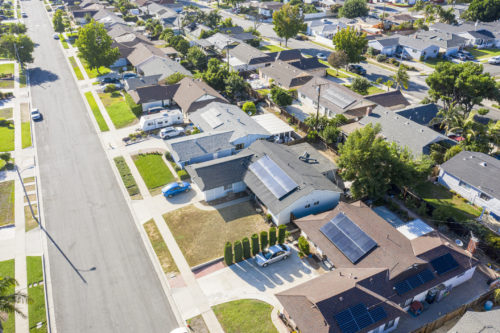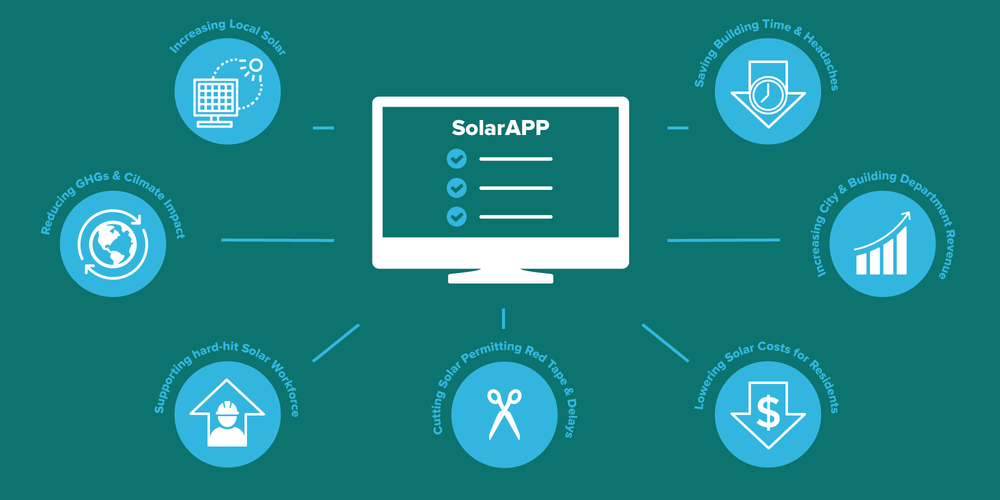A neighborhood in southern California where many homes have solar panels installed

How COVID-19 Is Pushing Cities to Change Solar Permitting for the Better
In order to meet social distancing requirements brought on by the COVID-19 pandemic, cities across the United States are moving permitting services, including solar, online. The International Code Council (ICC) recently surveyed its members and found that 65 percent of local code permitting officials have moved to remote work in response to the pandemic.
This sudden digital move has many local governments considering much-needed overhauls to their systems. To meet this urgent need, Rocky Mountain Institute is helping communities transition to NREL’s recently launched SolarAPP (Solar Automated Permit Processing) online platform. SolarAPP aims to standardize the instant permitting process across the United States to align with best practices in countries that are leading the way on residential solar.
By moving to the platform, local governments can support local solar jobs, attract business to their communities, relieve overburdened permitting departments, and increase tax and fee revenue. In addition, SolarAPP can save residents money and allow rooftop solar to finally realize its potential as a major climate and resilience solution in the United States.
Supporting the Hard-Hit Solar Workforce
The residential rooftop solar industry is a major job producer, primarily in small businesses. In 2019, residential solar represented over 90,000 of the 160,000 installation and project development solar jobs in the United States (of 250,000 total solar jobs), representing growth of 269 percent since 2010. Of those, 93 percent are with small businesses that employ fewer than 250 people.
COVID-19 has set back the solar industry significantly. SEIA estimates that 65,000 solar jobs have already been lost due to COVID-19, wiping out five years of job growth.
Implementing SolarAPP can help local governments spur solar job growth by attracting solar companies to work in their permitting-friendly jurisdictions and encouraging them to expand into new and untapped markets. To date, installers have entirely avoided some jurisdictions with onerous permitting, reinforcing the unequal distribution of solar industry effort; only five states account for two-thirds of all cumulative residential solar installations. By reducing the cost of rooftop solar, automated online permitting could further increase demand and the business activity and jobs that come with it.
Saving Building Departments Headaches, Time, and Money
Automating solar permitting can provide relief to overburdened local permitting and inspection departments. Some jurisdictions have reported receiving more permit applications for solar and battery storage than for any other building category. This will soon become the reality for many jurisdictions as home solar and storage cumulative capacity is projected to grow by more than two-fold and eighteen-fold, respectively, by 2025.
An automated permitting platform, like SolarAPP, with nationally standardized processes to ensure systems are code compliant will be essential for permitting departments to continue to achieve their mission of ensuring building safety in an effective and efficient manner. This will be particularly relevant for new battery storage systems that come with complications that officials may not be as familiar with.
In addition, automated permitting could free up staff time to work on other projects. While varying significantly by jurisdiction, it has been estimated that the average building department takes six staff hours to process a single permit. Compare that to an automated online platform where permit processing can occur almost instantaneously.
Increasing the number of permits processed also increases building department revenue since they are largely fee funded. For example, consider a department in a large solar market that processes 100 solar permits a month and charges a $200 permit fee. If automated permitting could process even 25 percent more permits, the department would generate $5,000 more in fee revenue per month to allocate at their discretion.
This increase in installs would also translate to an increase in around $6,000 per month in local sales tax income (assuming the average local sales tax rate of 1.4 percent). For local governments with revenue streams hit hard by COVID-19, this additional revenue is desperately needed.
Reducing the Delays and Costs for Residential Solar
Residential solar in the United States is more than twice as expensive as in other leading solar countries, costing around $3.30/W (national average estimates varying from $2.70/W to $3.70/W from NREL, SEIA/Wood Mackenzie, OpenSolar, and LBNL) versus around $1.10/W in Australia and $1.25/W in Germany. That’s $10,500 more for the typical 5 kW system.
These higher costs are partly due to solar’s soft costs, or non-hardware costs, such as permitting, inspection, and interconnection (PII); overhead; and customer acquisition. While soft costs account for approximately 65 percent of overall residential solar costs in the United States, they are only around 25 percent and 15 percent in Australia and Germany, respectively. One major factor in this difference is a national PII process in Germany and Australia versus an unstandardized and onerous PII process that varies across 18,000 local jurisdictions and more than 3,000 utilities in the United States.
This unstandardized process leads to customers in the United States waiting significantly longer, typically one to three months, for their installed system after they sign the contract. This drawn out process leads to much higher US customer cancellation rates—and the unique need for post-sale customer care teams. And as one might expect, cheaper and easier to install systems are also easier to sell. Customer acquisition costs are approximately $0.35/W in the United States versus only $0.05/W in Australia and Germany.
So, while direct permitting costs represent only a small percentage of soft costs, all of the indirect and hidden PII costs add up to a much larger amount. SEIA even estimates that SolarAPP could reduce solar costs by $1/W, or 30 percent of the upfront cost. With the positive feedback loop of cheaper systems and more efficient processes growing the solar industry, the cost reduction potential could be even greater.
Helping Rooftop Solar Become a True Climate Solution
If soft costs can be properly addressed, rooftop solar could finally unleash its potential as a distributed climate and community resilience solution. In 2016, NREL estimated that small buildings (less than 5,000 ft2) in the United States have enough rooftop area suitable for solar PV to generate 25 percent of total US electricity consumption (residential solar generated 0.5 percent of US electricity in 2019 and overall solar PV supplied 2.5%).
And while around 2.5 percent of US single family homes have rooftop solar, over 21 percent of Australia’s homes include rooftop solar. Achieving Australia’s residential solar penetration rate would result in 130 GW more of installed rooftop solar capacity (up from 15 GW), offsetting over 7 percent of US electrical consumption (up from 0.9 percent) and generating over $450 billion more economic activity (assuming $3.30/W) and 3.5 million jobs (assuming 26 solar jobs per MW by averaging estimates by NREL’s JEDI model [22], BNEF [23], and NREL’s solar installer survey [33]).
Local Governments Can Soon Join the Movement
A handful of US cities have already demonstrated that instant online permitting processes are possible. The City of San Luis Obispo, CA, implemented online and instant permitting starting in April 2020, and within weeks Sunrun achieved an industry-first same-day install. To fully address the soft-cost problem, however, we need to move past one-off solutions; cities across the country need to adopt a standardized online platform.
With support from the Department of Energy, NREL has worked over the past year to convene leaders in building safety and rooftop solar to develop the requirements for the SolarAPP instant permitting platform. NREL is currently testing SolarAPP with jurisdictions and will open the tool for broader adoption in the coming months.
To support interested communities, our team will allow participating communities in our upcoming residential solar cohort to pilot SolarAPP as part of a community bulk-purchasing campaign. This cohort will aim to accelerate community-wide rooftop solar adoption, with a particular focus on benefiting low-income and historically marginalized communities.
Moving to the SolarAPP online platform is a win-win for local governments and their residents. If your local government is interested in reducing solar costs, widening access to clean energy benefits, and accelerating community-wide adoption of rooftop solar, please reach out to Ryan Shea at rshea@rmi.org to learn more.
